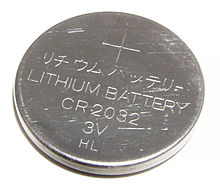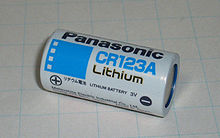Lithium manganese dioxide cell
The lithium manganese dioxide battery , usually just a single lithium manganese dioxide cell , is one of the non-rechargeable lithium batteries from the group of primary batteries . The anode is made of metallic lithium and the cathode is made of heat-treated manganese dioxide (MnO 2 ). The LiMnO 2 batteries are the most widely used lithium batteries commercially.
Electrochemistry
When discharging, Li (0) (metallic lithium ) is oxidized to Li (I) (Li + ions) in the anode . During the cathode reaction, the Mn (IV) of the MnO 2 is reduced to Mn (III), with LiMnO 2 being formed with the incorporation of the Li + ions .
Anode reaction:
Cathode reaction:
Overall reaction:
construction
The cathodes of lithium manganese dioxide cells are made from a paste that contains manganese dioxide powder, a binder (e.g. Teflon) and a material to increase conductivity (e.g. carbon black). In the case of the wound cells, a piece of metal mesh (e.g. expanded aluminum metal) serves as a carrier for the cathode. With button cells, the cathode and a lithium anode of the appropriate size are separated by a microporous separator. In the case of the wound cells, a cathode strip is wound into a roll together with a corresponding lithium strip and separator strips in between. As electrolyte solution is a lithium salt, z. B. lithium perchlorate (LiClO 4 ), in a mixture of organic solvents . The winding and electrolyte are located in the finished winding cell in a hermetically sealed, laser or plasma-welded cup made of nickel-coated steel or stainless steel.
The safety of lithium manganese dioxide cells has improved significantly in recent years, e.g. B. through the use of a shutdown separator made of a combination of polyethylene and polypropylene, which closes when heated to over 132 ° C, and the installation of rupture discs, which open at temperatures above 140 ° C and so in the event internal short circuits prevent cells from exploding. In addition, electrical circuits are used in batteries to prevent external short circuits and the recharging of cells.
properties
The nominal voltage of lithium manganese dioxide cells is 3.0 V and is therefore lower than that of lithium thionyl chloride and lithium sulfuryl chloride cells (3.6 V). On the other hand, significantly higher currents (up to approx. 5 A continuous load and 10 A pulse load for size D) can be achieved with Li-MnO 2 wound cells. Another advantage over all lithium batteries with a liquid cathode (lithium thionyl chloride, lithium sulfuryl chloride and lithium sulfur dioxide cells) is the significantly lower passivation of the lithium electrode, which prevents voltage drops at the beginning of the load ("voltage delay") and the cells are also suitable for extremely short current pulses. Lithium manganese dioxide cells are also characterized by their very good shelf life (at least 10 years). Disadvantages of the lithium manganese dioxide cell compared to the alternatives mentioned are its higher price and the somewhat more limited temperature range during use (−40 ° C to +70 ° C for LiMnO 2 cells compared to −55 ° C to +85 ° C for LiSOCl 2 cells).
Lithium manganese dioxide cells are available in many different sizes, with button cells with diameters between 9.5 and 30 mm being offered. In the case of wound cells, the most common types (arranged in increasing size) are 1/3 N (10.8 mm × 10.8 mm), 1/2 AA, CR-2, 2/3 AA, AA, 1/2 A, 2/3 A, CR-123A, A, C, D and DD.
The main areas of application for LiMnO 2 button cells are watches, pocket calculators and other small electronic devices. Smaller winding cells come z. B. in cameras (especially sizes CR-2 and CR-123A), as memory backup and in consumption meters. Larger wound cells are predestined for applications in which, after a long storage or rest period, a mains-independent supply with high currents is required. Examples are military applications, defibrillators, emergency transmitters and tracking devices. The largest commercially available size is a "Fat DD" cell (42 mm × 141 mm), which u. a. is used in space travel.
literature
- David Linden, Thomas B. Reddy (Eds.): Handbook of Batteries . 3. Edition. McGraw-Hill, New York 2002 ISBN 0-07-135978-8 .
Web links
- Primary Lithium Cells - Lithium Manganese Dioxide LiMnO 2 Technical manual and sales data for LiMnO 2 primary cells at Varta






